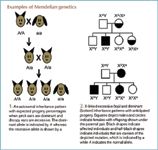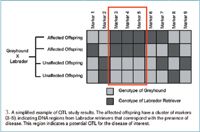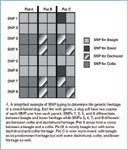Advances in canine genetic testing-and what these tests mean for you
See what these tests can already do for you and your patients-and what the future holds.
Most veterinary practitioners are faced with questions from owners regarding the genetics of their pets on a daily basis. Discussions include the risk of disease in certain breeds, assuredness of genetic heritage, and the breed assignment of mixed-breed pets with unknown parentage. Thanks to the advent of genetic DNA typing, practitioners are increasingly empowered with the means to answer these questions. Perhaps of most interest to practitioners is the ability to more accurately determine genetic disease risk. As in human medicine, the potential exists for personalized medicine for veterinary patients in which medical care is tailored to the individual patient based on his or her genetics. Practitioners interested in providing comprehensive care to their patients can now offer genetic testing as well as be a knowledgeable reference on the subject to their clients.
Genetic tests are available for many different domesticated species; however, in this article, I primarily focus on dogs. These tests include breed identification, parentage testing, phenotypic trait testing such as coat color, and genetic disease testing. This article focuses on those tests most relevant to practitioners, such as canine genetic disease testing, and includes information on the basic hereditary of genetic traits as well as an explanation of the science behind these tests.

Chris Amaral/Getty Images
CANINE GENOME
Studies into the origins of domestic dogs show a direct descent from wolves at least 14,000 years ago in probably two separate domestication events.1 Most modern dogs appear to have originated from the Middle Eastern wolf, with the basenji claiming the title of the most ancient breed in existence today.2,3 With the founding of The Kennel Club of Great Britain in 1873 and the American Kennel Club in 1884, breed registries were established. Soon to follow was the advent of the breed barrier rule in which both the sire and dam had to be recognized members of a breed for offspring to be eligible for registry. Thus, breeds arose from a limited genetic pool of animals that continue to be genetically isolated from each other.3
The selective breeding of this limited genetic pool has led to a spectacular diversity of phenotypic traits in dogs, part of what makes them such interesting partners to people. However, it comes with a downside—a high incidence of genetic diseases. Researchers have been investigating the genetic causes of heritable diseases in dogs since the 1960s.4 Technological advances and enhanced DNA database availability have increased the efficiency and ease of this research. The first canine genome was sequenced in 2003 by using DNA from a standard poodle.5 Since then, more in-depth sequencing has been performed and greatly expanded to include DNA from other breeds. Access to the genome sequences of multiple breeds has the potential to transform veterinary medicine by providing unique populations in which to study genetic diseases, ultimately leading to a better understanding of these diseases. Through genetic studies, the genes of breeds predisposed to certain diseases can be compared with the genes of resistant breeds. This limits the effects of enormous genetic diversity unrelated to the disease of interest that exists in the human population. The power of this type of analysis has made the dog a particularly attractive means to research diseases common to both dogs and people for the benefit of both.
GENETIC DISEASE TESTING
Thanks to the efforts of genetic researchers, many canine genetic disease tests are commercially available (Table 1 (PDF)). Single gene mutations have been identified as the cause of most of these diseases. An understanding of the different inheritance patterns is required when recommending testing and in interpreting the results. Mutated genes can be expressed in a dominant or recessive manner and can be located on autosomal or sex chromosomes. All of these factors affect how the mutation impacts the animal.
Most of the causative genes identified are inherited in an autosomal recessive manner. Remembering that most cells have two copies of each chromosome and, thus, two copies of each gene, an autosomal recessive disease requires two copies of the defective gene for disease to occur. A carrier of an autosomal recessive disease is an animal that has one normal gene and one defective gene (heterozygous) with no disease signs (Figure 1). This animal can pass the defective gene to its offspring, and, if mated with another carrier, the offspring will have a 25% chance of being homozygous for the mutation and suffering from the disease. Without genetic testing, prospective identification of mutation carriers involves progeny testing from matings with known carriers—a difficult task. Generally, results of genetic testing for autosomal recessive traits are reported as "negative" or "normal" (no mutation on either gene), "carrier" (one mutation), or "positive" or "affected" (both copies of the gene are mutated).

Figures 1 and 2: Examples of Mendelian genetics
Many other types of inheritance patterns exist, including autosomal dominant diseases, X-linked diseases, mutations with incomplete penetrance, and polygenic diseases. Autosomal dominant diseases have no carrier state. If one copy of the mutation is present, then the associated disease is present. For example, dominant progressive retinal atrophy will be present in a dog with just one copy of the mutated RHO gene. Sex-linked traits occur when the mutated gene is located on a sex chromosome and can be recessive or dominant (Figure 2). An X-linked recessive mutation would affect more males than females since males have only one X chromosome, with females requiring two copies of the mutation to be affected, as is the case of hemophilia B in bull terriers. An X-linked dominant mutation would typically affect more females than males.
Autosomal dominant mutations with mixed penetrance are more complicated. In this type of inheritance pattern, the variable disease expression is thought to depend on other genetic or environmental risk factors. An example of this type of inheritance pattern is hereditary cataracts in Australian shepherds.6 One copy of the mutated gene results in a greater risk for cataract development but does not guarantee disease will develop. Conversely, a few dogs in the study did not carry the mutation but developed cataracts. This genetic test may be most useful to breeders of Australian shepherds selecting to decrease risk of this disease in their lines.
Some disorders have an even more complex genetic etiology in which molecular variation in many genes contributes to disease. Patterns of such polygenic inheritance are commonly studied by genetic marker mapping studies in which the typing of hundreds to thousands of genetically variant DNA markers spaced across the entire genome are used to derive correlations between the genetic markers and disease. DNA markers have been identified that are associated with certain diseases for which the causative gene is unknown. These marker tests carry a higher risk of inaccuracy since the mutant gene itself cannot be directly tested, but they can still provide valuable information.
One example is quantitative trait loci (QTL) studies, which have been performed to help unravel the genetic basis of canine hip dysplasia.7-9 In one study, an affected breed, the Labrador retriever, was crossed with a resistant breed, the greyhound (Figure 3).7 Three generations of offspring were evaluated for hip dysplasia by using radiographic techniques and then typed by using known genetic markers that differ between Labrador retrievers and greyhounds. This effort led to the identification of 12 Labrador retriever QTL in the crossbred offspring that correlated with the presence of hip dysplasia.

Figure 3
More recent studies have surveyed hundreds of German shepherds and Labrador retrievers for radiographic evidence of hip dysplasia and then looked for the genetic markers that correlate with disease expression.8,9 These studies have found QTL that overlap with those in the Labrador retriever-greyhound study as well as additional novel QTL. However, QTL analysis is based on DNA marker associations. In this way, they are signposts of genetic regions that harbor the genes that cause disease. The next step is to identify the specific mutated genes that are responsible for the genetic disorder.
It is not always clear which type of test is being offered (markers or specific genes) as some genetic testing providers guard the specifics of their testing as proprietary. When provided, statistical relevance of the test to the disease offers you some assurance of the test's reliability and clinical worth.
Finally, a single clinical disease may be caused by mutations in different genes in different breeds. For example, progressive retinal atrophy can be caused by any one of 15 mutations in 11 genes in 34 breeds.10 Two unrelated mutations can also occur in the same gene. In retinal cone degeneration, the CNGB3 gene has a missense mutation in German shorthaired pointers and a deletion mutation in Alaskan malamutes. These mutations arose spontaneously and independently of each other in these two breeds but cause the same clinical disease. Given these variations, you should be aware that certain genetic tests are recommended only for specific breeds. The genetic test should be validated for the particular breed being tested.
Most of the disease-causing mutations listed in Table 1 (PDF) have been published in scientific journals and are referenced if applicable. Several organizations provide information on available genetic tests through their websites, such as the Orthopedic Foundation for Animals (www.offa.org), the Canine Genetic Diseases Network (www.caninegeneticdiseases.net), and the National Human Genome Research Institute (NHGRI) Dog Genome Project (research.nhgri.nih.gov/dog_genome). Additional resources for available tests include veterinary genetic test providers, such as OptiGen and VetGen.
CANINE BREED TESTING
Owners interested in learning the breed makeup of their mixed-breed pets can now use genetic testing to find out this information. Although owners can obtain these results without consulting you, it is beneficial for you to understand the science behind these tests to answer clients' questions and realize the limitations of these tests.
The unique genetic signatures of many dog breeds have been identified. A single nucleotide polymorphism (SNP) is one such signature. A SNP is simply the change of a single nucleotide to another in the DNA sequence and can occur anywhere in the genome. As dogs are selectively bred over time, specific SNPs can become concentrated in that breed. For example, a SNP may be located close to a gene involved in curly hair. As dogs are selectively bred for curly hair, that closely linked SNP is also inadvertently selected. If a SNP or certain combination of SNPs is present in a certain dog breed and not in other breeds, it can be used as a marker for identifying that breed through DNA analysis. To identify its parental breeds, a mixed-breed dog's DNA can be analyzed for these SNPs and then compared with known purebred SNP profiles (Figure 4). For example, if a dog has a large percentage of SNP combinations found mainly in boxers, then it most likely has a boxer in its pedigree. If this same dog also has several SNPs common to beagles, then it likely has a beagle relative, as well.

Figure 4
Canine breed identification is available from numerous companies for less than $100 a sample. Most companies will send the test kit directly to the pet owner, and the DNA sample is collected using a cheek swab. The exception is the Wisdom Panel Professional (Mars Incorporated), which analyzes a large number of breeds using numerous SNPs and requires a sample of whole blood.11 The number of SNPs analyzed varies by company, and, in general, the more SNPs analyzed, the higher the accuracy of the test results. Perhaps of secondary importance is the number of breeds included in the analysis, as several providers state that about 62 breeds contribute to 92% of the genetics in the U.S. dog population.12-14
While the main interest in this testing may be to satisfy owner curiosity, it does have value to practitioners. Preventive care can be better tailored with knowledge of a pet's pedigree. Although breed typing cannot truly be associated with inherited disease risk, it can serve as a starting place. An example of testing's potential value is that a primarily boxer-mixed dog would be at higher risk of carrying the autosomal dominant mutation for arrhythmogenic right ventricular cardiomyopathy. Insight into this pedigree would give the owners the option to test directly for the STRN mutation, the causative gene in arrhythmogenic right ventricular cardiomyopathy, and to consider more in-depth cardiac monitoring for their pets.
Both genetics and environment determine behavior, and pedigree typing is not considered an accurate method to assess temperament or predict most behaviors in mixed-breed dogs. However, studies have found that a limited list of behaviors including territorial defense, playfulness, and excitability have a strong genetic component independent of environmental influences, suggesting that knowledge of a dog's pedigree may be helpful in better anticipating and managing these specific behaviors.15
THE FUTURE OF THE FIELD
Genetic disease testing can have a significant impact on improving canine health. These efforts will come from breeding to decrease the prevalence of detrimental genetic mutations, the replacement of cumbersome and invasive testing methodologies, and improved monitoring and treatment of clinical disease. Indeed, the testing of Irish setters by breeders for progressive retinal atrophy resulted in a dramatic decrease in this disease in the United Kingdom in the span of only six years.16
Efforts to completely eliminate a mutation may reduce genetic diversity to the detriment of the breed, and, considering the already severely limited gene pools of many breeds, caution must be taken. For example, veterinarians assisting breeders to reduce disease incidence in their line may recommend breedings that are aimed at reducing the percentage of offspring homozygous for recessive traits. The best method for diluting genetic disease and increasing genetic diversity is breeding outside of the breed; however, many breed registries prohibit that with closed studbooks. Genetic registries are being created by various organizations, including kennel clubs and breed organizations, through which animals can be certified free of certain genetic mutations. Be aware that many registries require that specific laboratories perform the testing, and this requirement should be taken into consideration at the outset in these cases.
Aside from assisting breeders, genetic testing is clinically relevant for diseases that are diagnosed either by exclusion, such as degenerative myelopathy, or by invasive diagnostic tests, such as liver biopsy for copper toxicosis. Testing for the MDR1 mutation responsible for the multi-drug sensitivity seen in many herding breeds would benefit the patient and the practitioner as the list of problem drugs for these pets continues to grow.17 Genetic testing can also be used to help guide the monitoring and testing of at-risk patients. Owners of boxers, for instance, may see greater value in routine cardiac monitoring if they know their pets are genetically at risk for heart disease. Veterinarians can also assist clients searching for their next pet by understanding the genetic pedigrees made available by breeders, which impacts the future health of those offspring.
Genetics is at the forefront of medicine for both people and animals, with interest in comparative medicine on the rise. The One Health Initiative is a collaborative effort between the human medical community and veterinary organizations to combine efforts to improve the lives of all species. In conjunction with the NHGRI at the National Institutes of Health, the NHGRI Dog Genome Project is actively working to further knowledge of the canine genome by identifying genes responsible for breed phenotypes such as chondrodysplasia as well as other genome mapping projects.
As the dog becomes increasingly valued for its unique genetic diversity, interest in it as a model for human genetic disease will no doubt continue to increase with benefits for both species. The list of causative genes identified for canine disease will continue to grow as will the list of genetic tests available to veterinarians, pet owners, and breeders. Personalized medicine for the veterinary patient is right around the corner—if not already here—and you have the tools to provide that level of care. The purebred canine community has the advantage of influencing the health of the next generation through careful breeding. Through education and guidance from veterinarians, many of the mutations listed in Table 1 (PDF) could become increasingly less prevalent. Veterinarians knowledgeable in genetic testing can assist patients suffering from genetic disease in receiving more accurate and timely diagnoses, which leads to the ultimate goal of better care.
ACKNOWLEDGEMENTS
The author would like to thank her mentor, Derry Roopenian, PhD, of the Jackson Laboratory, for his help and support, as well as Anne Peaston, BVSc, DipVetClinStud, PhD, DACVIM (oncology), of the University of Adelaide, and Jill Recla of the Jackson Laboratory for their valuable insights.
Caroline G. McPhee, DVM, PhD
The Jackson Laboratory
600 Main St.
Bar Harbor, ME 04609
REFERENCES
1. Vila C, Savolainen P, Maldonado JE, et al. Multiple and ancient origins of the domestic dog. Science 1997;276:1687-1689.
2. Vonholdt BM, Pollinger JP, Lohmueller KE, et al. Genome-wide SNP and haplotype analyses reveal a rich history underlying dog domestication. Nature 2004;464:898-902.
3. Parker HG, Kim LV, Sutter NB, et al. Genetic structure of the purebred domestic dog. Science 2004;304:1160-1164.
4. Shive RJ, Hare WC, Patterson DF. Chromosome studies in dogs with congenital cardiac defects. Cytogenetics 1965;4:340-348.
5. Kirkness EF, Bafna V, Halpern AL, et al. The dog genome: survey sequencing and comparative analysis. Science 2003;301:1898-1903.
6. Mellersh CS, McLaughlin B, Ahonen S, et al. Mutation in HSF4 is associated with hereditary cataract in the Australian Shepherd. Vet Ophthalmol 2009;12:372-378.
7. Todhunter RJ, Mateescu R, Lust G, et al. Quantitative trait loci for hip dysplasia in a cross-breed canine pedigree. Mamm Genome 2005;16:720-730.
8. Phavaphutanon J, Mateescu RG, Tsai KL, et al. Evaluation of quantitative trait loci for hip dysplasia in Labrador Retrievers. Am J Vet Res 2009;70:1094-1101.
9. Marschall Y, Distl O. Mapping quantitative trait loci for canine hip dysplasia in German Shepherd dogs. Mamm Genome 2007;18:861-870.
10. Miyadera K, Kato K, Aguirre-Hernandez J, et al. Phenotypic variation and genotype-phenotype discordance in canine cone-rod dystrophy with an RPGRIP1 mutation. Mol Vis 2009;15:2287-2305.
11. Mars Incorporated. Wisdom Panel Professional Mixed-Breed Genetic Analysis, 2010.
12. Sundberg JP, Boggess D, Silva KA, et al. Major locus on mouse chromosome 17 and minor locus on chromosome 9 are linked with alopecia areata in C3H/HeJ mice. J Invest Dermatol 2003;120:771-775.
13. DNA Breed Identification. Frequently Asked Questions. Available at: www.DNABreedID.com. Accessed Nov 1, 2011.
14. Happy Dog DNA. Dog DNA Test FAQs. Available at: www.happydogdna.com. Accessed Nov 1, 2011.
15. Takeuchi Y, Mori Y. A comparison of the behavioral profiles of purebred dogs in Japan to profiles of those in the United States and the United Kingdom. J Vet Med Sci 2006;68:789-796.
16. Kuska B. Sit, DNA, sit: cancer genetics going to the dogs. J Natl Cancer Inst 1999;91:204-206.
17. College of Veterinary Medicine Veterinary Clinical Pharmacology Lab. Problem drugs. Washington State University, Pullman, Wash., 2009.
Podcast CE: A Surgeon’s Perspective on Current Trends for the Management of Osteoarthritis, Part 1
May 17th 2024David L. Dycus, DVM, MS, CCRP, DACVS joins Adam Christman, DVM, MBA, to discuss a proactive approach to the diagnosis of osteoarthritis and the best tools for general practice.
Listen